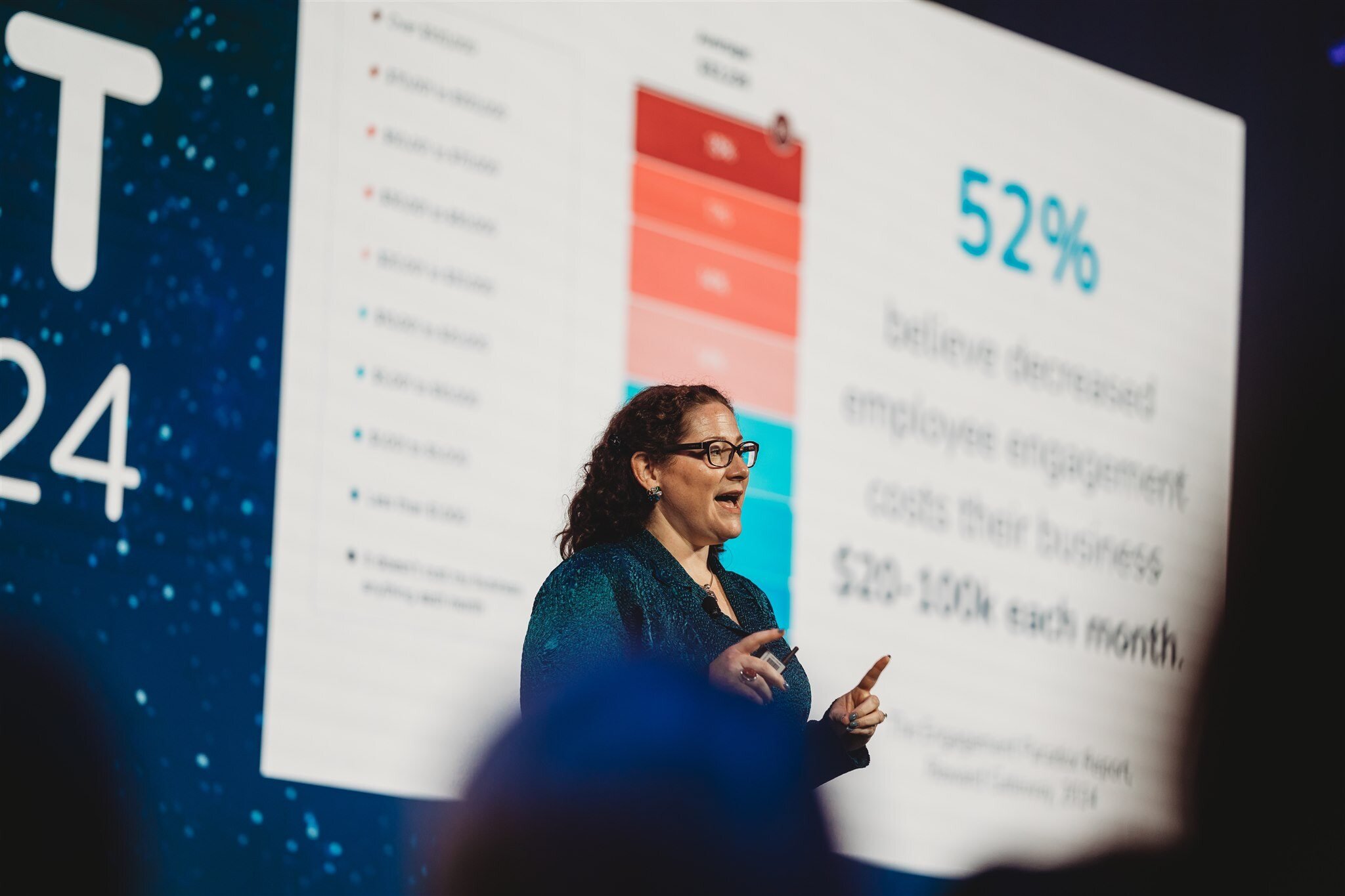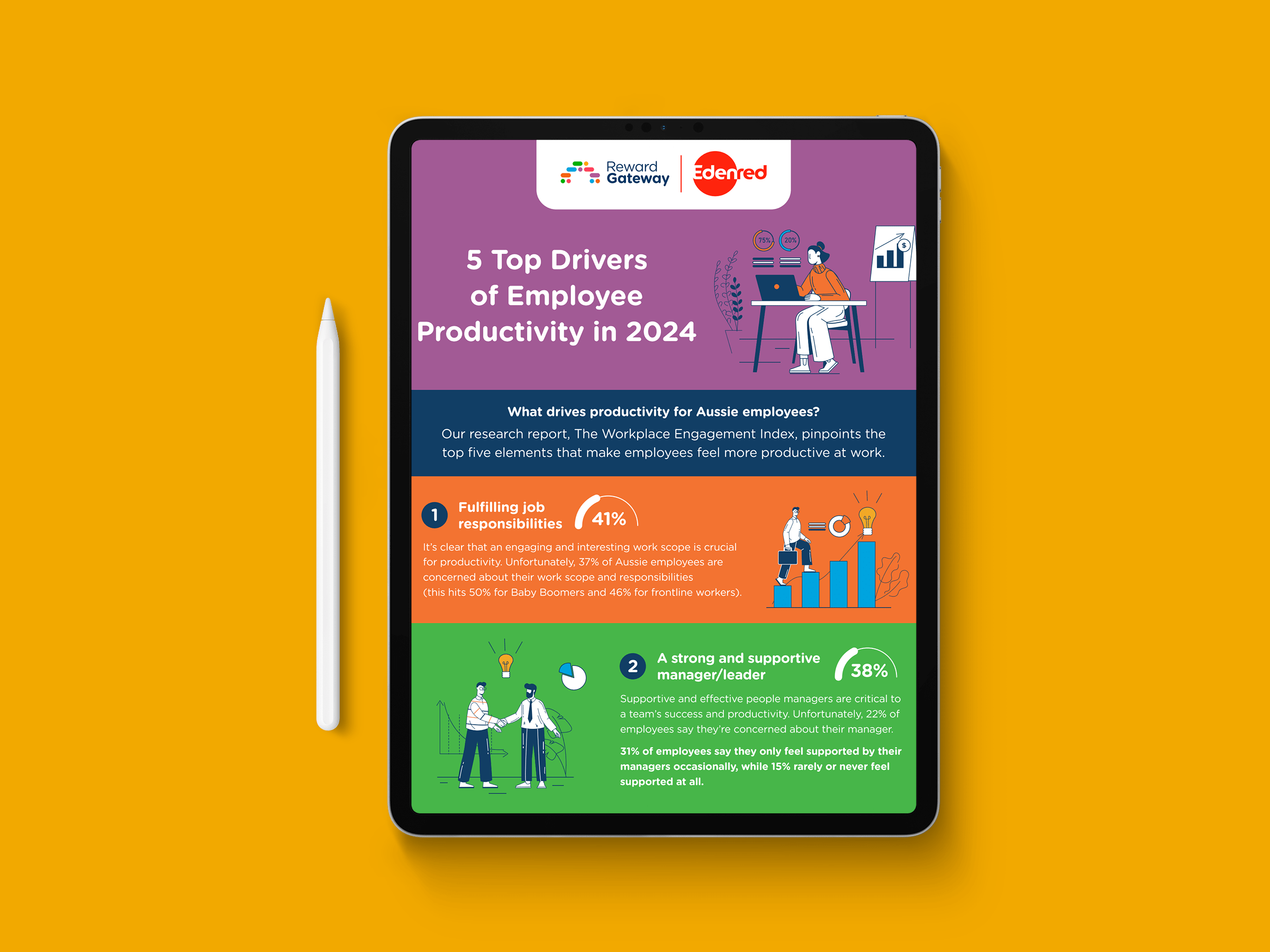Employee engagement has always been a critical element of workplace success. But the Australian workplace is currently grappling with a number of key employee engagement paradoxes that are significantly impacting productivity and performance.
In this blog, we’ll explore five key paradoxes that are affecting employee engagement and what organisations can do to build more effective and motivated teams.
Paradox 1. Retention is up, but engagement is down
One of the most perplexing aspects of the modern workplace is the divergence between retention and engagement. Traditionally, high retention has been viewed as a sign of a healthy work environment. However, despite retaining employees, businesses are seeing plummeting engagement levels, according to our Engagement Paradox Report.
While employee retention is up with 45% of Australian employees saying they’re not looking to change roles within the next two years, engagement and happiness are down with just over one in four employees admitting that they are less engaged at work compared to the last 12 months and one in three reporting a low level of happiness in their roles. Despite this, they want to stay, so what's causing this paradox?
Our research found a range of contributing factors, including work-related burnout, cost of living, general stress, lack of appreciation and recognition, poor mental wellbeing and a lack of connection.
Interestingly, 74% of Australian employees say they would move jobs when economic conditions improve, demonstrating the ripple effects of the cost of living and its role in this paradox.
Australian business leaders understand why this paradox is such a business-critical issue, with 87% of business and HR decision makers stating that poor employee engagement impacts employee performance, and therefore business performance.
Paradox 2. We need to get more done with less vs. we need to give people less to do, to get more done
Many workplaces are seeing higher stress levels and burnout, which directly correlates with disengagement. According to our research, 69% of managers report that their team’s mental health concerns and burnout are adding pressure to their roles. When employees are overworked, they struggle to stay engaged, leading to diminished productivity, even if they remain in their jobs.
Combatting this paradox requires addressing work-related burnout. Organisations must move away from the mindset of working employees harder to get results. Instead, they should allow people to focus and prioritise. By removing non-mission-critical tasks from to-do lists, employees can concentrate on what truly matters, leading to better engagement and performance.
Myth: Hard work equals better results.
Reality: Allowing people the space to focus and prioritise leads to better outcomes.
Many businesses believe that to succeed, they need to squeeze more out of their employees, particularly in lean times. This has created a “more with less” culture that only exacerbates burnout and disengagement.
Overworked employees don’t have the mental capacity to be innovative or empathetic—two qualities essential for leadership and team cohesion. When people are stressed and burnt out, they lack the bandwidth to engage in deep, meaningful work.
Want to hear more about this, including in-depth insights and more actionable tips? Check out our recent webinar: Addressing the Engagement Paradox: How to Build a High-Performing Team in a High-Risk Economy.
Paradox 3. Focus on the work to be done and the criteria for success vs. focus on the people and remove the roadblocks to success
A common approach in leadership is to focus on the work that needs to get done and the criteria for success. However, this can create a paradox where employees feel like cogs in a machine rather than valued team members. In reality, employees need to feel supported and understood before they'll give discretionary effort.
Myth: If you’re too nice, employees will take advantage, creating entitlement.
Reality: Employees are more likely to go the extra mile when they feel their leaders care about them.
By focusing on removing roadblocks and providing employees with the tools they need to succeed, leaders can create an environment where employees feel motivated to perform. When companies shift the emphasis from just the work to also supporting the workers, they unlock greater levels of engagement. Check out our recent blog on supporting middle managers to better support your people for more tips.
Paradox 4. Recognition is for when you get results vs. recognition gets you the results
Many companies limit recognition to when employees achieve specific results or hit targets.
 However, this approach can actually hinder long-term engagement. Employees need consistent motivation, especially when they’re in the middle of a challenging project.
However, this approach can actually hinder long-term engagement. Employees need consistent motivation, especially when they’re in the middle of a challenging project.
Myth: Recognition is only for when goals are reached.
Reality: Recognising progress keeps employees motivated throughout the journey.
Recognition isn’t just a reward for hitting the mark—it’s a tool that drives consistent performance.
Acknowledging small wins, progress and effort creates a cycle of motivation that pushes employees toward bigger goals.
Paradox 5. Provide more channels for communication and connection vs. disconnecting can lead to intentional and effective connection
The expectation that your people should always be available has led to communication overload. Many organisations believe that more channels for communication will foster better connections and collaboration. However, the paradox here is that constant communication can reduce efficiency and connection quality.
Myth: High performers should be online all the time.
Reality: High performers are selective and efficient about how they spend their time.

Effective communication isn’t about quantity; it’s about quality. The key to creating cultures where people thrive and can achieve the right balance for them is open and honest communication.
Always-on communications and having a centralised place for 'mission critical' employee communications gives organisations the flexibility to share communications with their teams in an easy-to-digest format that can be accessed on-demand. Video and written communication give employees flexibility in how they consume information. Blogs, a leadership Q&A or video chats with the executive team are all ways in which you can foster open and honest dialogue while still giving people the right to disconnect when they're not working.
Many employers work in distributed and global workforces so they have already focused on tools where employees can stay connected at times that best suit them. Our employee engagement platform enables businesses to create digital communities where employees can connect and feel like they belong. Custom pages that explore how employees can achieve balance at work, inclusive of wellbeing resources, policies, procedures and access to tools and support, help employees understand the flexibility they have with their manager and employer. For companies that have compliance obligations, our communications tool has an "I've read this" button to ensure People Teams are capturing the engagement in specific communications.
The Australian workplace faces several engagement paradoxes, but understanding and addressing them can lead to more productive and engaged teams.
By shifting focus from simply getting more done to giving employees the tools and space they need to succeed, leaders can cultivate a more engaged, resilient workforce.
Engagement isn't about working harder or communicating more—it’s about working smarter and communicating better. Through empathetic leadership, recognition and intentional connection, Australian organisations can navigate these paradoxes and drive success.
Get in touch with one of our team today to learn how you can supercharge employee engagement at your business.
 Joy Adan
Joy Adan



